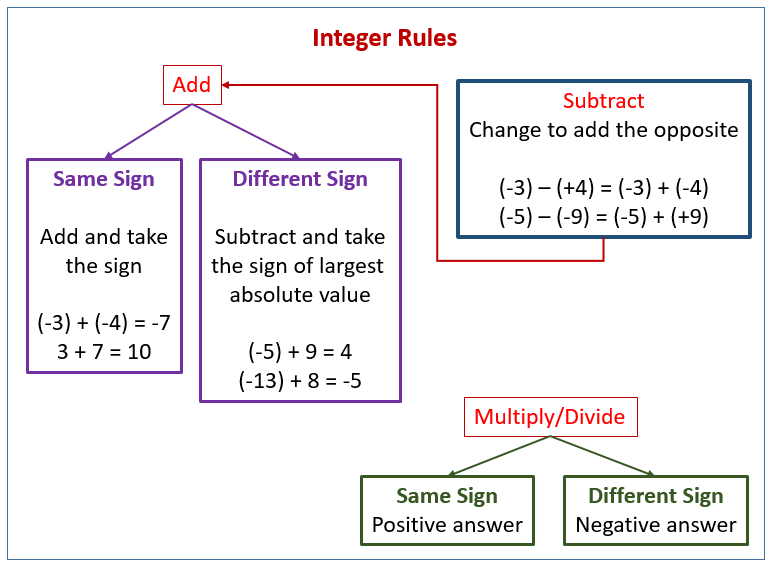

The same rules hold true for multiplication. Adding Rules: Positive + Positive Positive: 5 + 4 9 Negative + Negative Negative: (- 7) + (- 2) - 9 The sum of a negative and a positive number: First subtract: The answer gets the sign of the larger number (- 7) + 4 -3 (- 3) + 7 4 6 + (-9) - 3 5 + ( -3) 2 2. When you divide two negative numbers then the quotient is positive. When you divide a positive number by a negative number then the quotient is also negative. When the first number is positive, it is usual to omit. Adding two negative numbers yields a negative number. When adding numbers with the same sign, you can omit the brackets and the + sign for the addition. When you divide a negative number by a positive number then the quotient is negative. Adding and Subtracting Negative Numbers Adding two positive numbers yields a positive number. So, the quotient of a negative and a positive number is negative and, correspondingly, the quotient of a positive and a negative number is also negative.

What happens when you divide two negative numbers? For example,įor the denominator (-3) to become the numerator (-12), you would have to multiply it by 4, therefore the quotient is 4. In order to check whether 4 is the correct answer, we multiply 3 (the denominator) by 4 (the quotient): When adding a negative and a positive integer together, subtract the integers. Multiplication and division: same sign positive different sign negative. If you answer is correct then the product of these two numbers should be the same as the numerator. Negative integers have rules for performing different calculations. for equations with different signs the number with the higher absolute value take the sign of the answer. Turning to division, you may recall that you can confirm the answer you get by multiplying the quotient by the denominator. Now we have two negative numbers, so the result is positive. Since there is one positive and one negative number, the product is negative 12. Two quick multiplication examples:ģ times 4 equals 12. In multiplication and division, however, you calculate the result as if there were no minus signs and then look at the signs to determine whether your result is positive or negative. For example: this is what you have learned all along.
#NEGATIVE AND POSITIVE RULES IN ADDITION PLUS#
This is similar to the rule for adding and subtracting: two minus signs become a plus, while a plus and a minus become a minus. Rule 1: Adding positive numbers to positive numbersit’s just normal addition. When you multiply two negative numbers or two positive numbers then the product is always positive. When you multiply a negative number by a positive number then the product is always negative. You also have to pay attention to the signs when you multiply and divide. for equations with different signs the number with the higher absolute value take the sign of the answer.


 0 kommentar(er)
0 kommentar(er)
